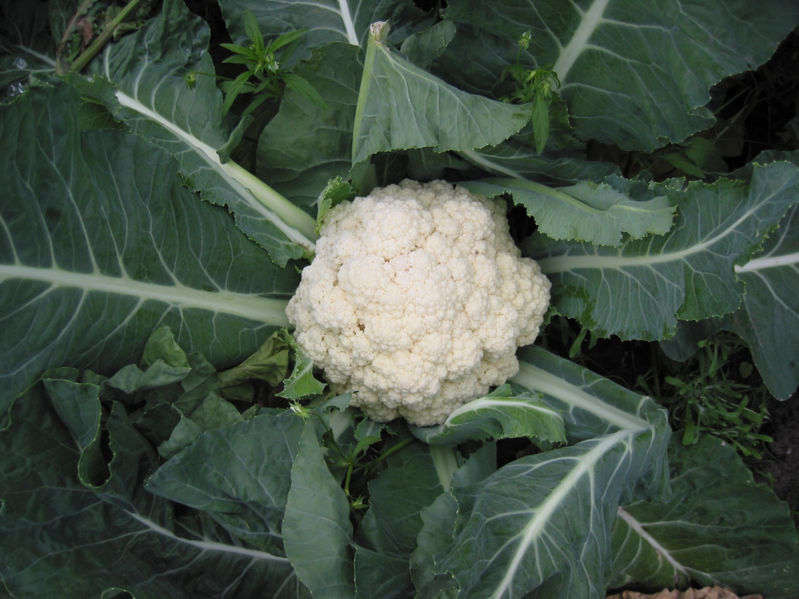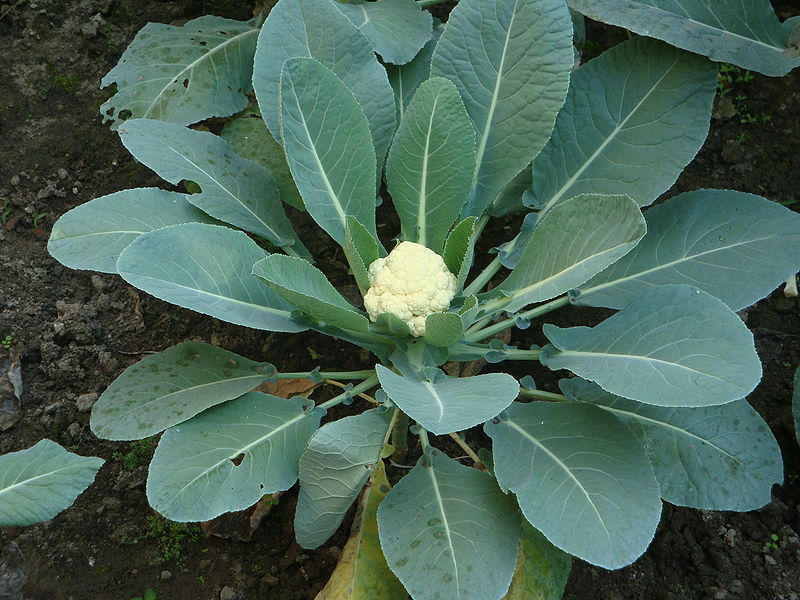 |
|
http://commons.wikimedia.org/wiki/User:Qurqa |
 |
| http://commons.wikimedia.org/wiki/File:Growing_Cauliflower.jpg |
Translate this page:
Summary
Physical Characteristics

 Brassica oleracea botrytis is a BIENNIAL growing to 0.8 m (2ft 7in).
Brassica oleracea botrytis is a BIENNIAL growing to 0.8 m (2ft 7in).
See above for USDA hardiness. It is hardy to UK zone 4 and is not frost tender. It is in flower from May to August, and the seeds ripen from July to September. The species is hermaphrodite (has both male and female organs) and is pollinated by Bees. The plant is self-fertile.
Suitable for: light (sandy), medium (loamy) and heavy (clay) soils, prefers well-drained soil and can grow in heavy clay soil. Suitable pH: mildly acid, neutral and basic (mildly alkaline) soils. It can grow in semi-shade (light woodland) or no shade. It prefers moist soil. The plant can tolerate maritime exposure.
UK Hardiness Map
US Hardiness Map
Synonyms
Plant Habitats
Cultivated Beds;
Edible Uses
Edible Parts: Flowers Leaves
Edible Uses:
Immature flowering head - raw or cooked[1, 16, 37, 46]. A mild cabbage-like flavour, they make an excellent cooked vegetable and are also very acceptable in salads[K]. By careful selection of cultivars, it is possible to produce flowering heads all year round[K]. Leaves - cooked[37]. A mild cabbage flavour, they make a good cooked vegetable[K]. Do not over-harvest them, however, since this would adversely affect the production of the flowering head[K].
References More on Edible Uses
Medicinal Uses
Plants For A Future can not take any responsibility for any adverse effects from the use of plants. Always seek advice from a professional before using a plant medicinally.
None known
References More on Medicinal Uses
The Bookshop: Edible Plant Books
Our Latest books on Perennial Plants For Food Forests and Permaculture Gardens in paperback or digital formats.

Edible Tropical Plants
Food Forest Plants for Hotter Conditions: 250+ Plants For Tropical Food Forests & Permaculture Gardens.
More

Edible Temperate Plants
Plants for Your Food Forest: 500 Plants for Temperate Food Forests & Permaculture Gardens.
More

More Books
PFAF have eight books available in paperback and digital formats. Browse the shop for more information.
Shop Now
Other Uses
Companion Fungicide
An extract of the seeds inactivates the bacteria that causes black rot[20, 201]. Grows well with celery and other aromatic plants since these seem to deter insect predations[18, 20, 201]. Grows badly with beet, tomatoes, onions and strawberries[20, 201].
Special Uses
Dynamic accumulator
References More on Other Uses
Cultivation details
Succeeds in full sun in a well-drained moisture-retentive fertile soil with plenty of lime[37, 200, 264]. Cauliflowers, especially the winter and spring maturing types, should not be given a soil that is too rich in nitrogen since this can encourage soft, sappy growth that is more susceptible to winter cold damage[264]. Prefers a heavy soil[16]. Requires a warm sunny position[16]. Prefers a pH in the range 6 to 7[200], though it tolerates a pH in the range 4.3 to 8.3. Succeeds in maritime gardens[200]. Lack of moisture in the growing season can cause the plant to produce small or deformed curds[264]. Summer varieties are not very cold hardy and will be damaged by light frosts, winter cauliflower plants are more hardy and will tolerate temperatures down to about -6°c, though the curds are more sensitive and can suffer damage at about -2°c[200]. This damage can often be prevented by bending over the leaves so that they cover the curd. Cauliflowers are widely grown for their edible immature flower heads (or curd). There are many named varieties and, by careful selection, it is possible to provide a year round supply. The summer and autumn maturing cultivars are annuals, they need to produce a certain number of leaves before curd development will be initiated. The optimum temperature for this is around 17°c, but at temperatures above 20°c the curds will either be of poor quality or not be produced at all[200]. Winter and spring maturing forms are biennial and need exposure to temperatures below 10°c before they will produce curds and once again, this will not happen unless the plant has reached a certain size[200]. Grows well with celery and other aromatic plants since these seem to deter insect predations[18, 20, 201]. Grows badly with beet, tomatoes, onions and strawberries[20, 201].
References Carbon Farming Information and Carbon Sequestration Information
Temperature Converter
Type a value in the Celsius field to convert the value to Fahrenheit:
Fahrenheit:
The PFAF Bookshop
Plants For A Future have a number of books available in paperback and digital form. Book titles include Edible Plants, Edible Perennials, Edible Trees,Edible Shrubs, Woodland Gardening, and Temperate Food Forest Plants. Our new book is Food Forest Plants For Hotter Conditions (Tropical and Sub-Tropical).
Shop Now
Plant Propagation
Seed - sow in a seedbed outdoors in April to June depending on the cultivar. Plant out into their permanent position when the plants are 5 - 10cm tall. Seed of some cultivars can be sown in late winter in a greenhouse in order to obtain a harvest in early summer. Do not let the seedlings get overcrowded or they will soon become leggy and will not make such good plants. If your seedlings do get leggy, it is possible to plant them rather deeper into the soil - the buried stems will soon form roots and the plant will be better supported.
Other Names
If available other names are mentioned here
Native Range
(Brassica oleracea) EUROPE: United Kingdom (U.K.) (coasts), Germany, Schleswig-Holstein, Spain (n. coast), France (w. & n. coasts).
Weed Potential
Right plant wrong place. We are currently updating this section.
Please note that a plant may be invasive in one area but may not in your area so it's worth checking.
Conservation Status
IUCN Red List of Threatened Plants Status :

| Related Plants
|
| Latin Name | Common Name | Habit | Height | Hardiness | Growth | Soil | Shade | Moisture | Edible | Medicinal | Other |
| Alliaria petiolata | Garlic Mustard | Biennial | 1.0 |
5-8
| | LMH | FS | MWe | 3 | 2 | 1 |
| Alyssum alyssoides | Pale Madwort | Annual | 0.2 |
4-8
| F | LM | SN | DM | 2 | 0 | 0 |
| Arabidopsis thaliana | Thale Cress, Mouseear cress | Annual/Biennial | 0.5 |
0-0
| | LMH | SN | DM | 0 | 1 | 1 |
| Arabis alpina | Alpine Rock Cress, Alpine rockcress | Perennial | 0.2 |
4-8
| | LM | SN | M | 2 | 0 | |
| Arabis caucasica | Rock Cress, Wall Rockcress | Perennial | 0.2 |
4-9
| M | LMH | SN | DM | 2 | 0 | 3 |
| Arabis hirsuta | Hairy rockcress, Mountain rockcress, Creamflower rockcress | Biennial/Perennial | 0.6 |
4-8
| | LMH | SN | DM | 1 | 0 | |
| Arabis lyrata | Rock Cress, Kamchatka rockcress, Lyrate rockcress | Biennial/Perennial | 0.3 |
4-8
| | LMH | SN | DM | 1 | 0 | |
| Arabis pendula | | Biennial | 0.9 |
-
| | LMH | FSN | M | 1 | 0 | |
| Arabis sagittata | | Biennial/Perennial | 0.6 |
-
| | LMH | SN | DM | 1 | 0 | |
| Arabis serrata | | Perennial | 0.3 |
6-9
| | LMH | SN | M | 1 | 0 | |
| Armoracia rusticana | Horseradish, Red Cole | Perennial | 0.7 |
4-9
| F | LMH | SN | M | 3 | 3 | 2 |
| Aubrieta deltoidea | Aubretia, Lilacbush, False Rockcress | Perennial | 0.2 |
4-9
| M | LM | SN | DM | 0 | 0 | 3 |
| Aurinia saxatilis | Golden Alyssum, Basket of gold | Perennial | 0.3 |
4-10
| M | LMH | N | DM | 0 | 0 | 3 |
| Barbarea australis | | Biennial/Perennial | 0.5 |
-
| | LMH | SN | M | 2 | 1 | |
| Barbarea orthoceras | American Yellowrocket | Perennial | 0.5 |
3-8
| | LMH | SN | M | 3 | 0 | 1 |
| Barbarea stricta | Small-flowered winter-cress | Biennial | 0.8 |
3-10
| F | LMH | N | MWe | 2 | 0 | 0 |
| Barbarea verna | Land Cress, Early yellowrocket | Biennial | 0.3 |
4-9
| | LMH | SN | M | 3 | 0 | 1 |
| Barbarea vulgaris | Yellow Rocket, Garden yellowrocket | Perennial | 0.4 |
3-9
| | LMH | SN | M | 3 | 1 | 1 |
| Brassica balearica | | Perennial | 0.0 |
-
| | LMH | N | M | 1 | 0 | |
| Brassica carinata | Abyssinian Cabbage | Annual | 1.0 |
9-12
| F | LMH | SN | M | 4 | 2 | 3 |
| Brassica cretica | Mustard | Perennial | 1.0 |
0-0
| | LMH | N | M | 2 | 0 | |
| Brassica elongata | Elongated mustard | Biennial/Perennial | 0.9 |
0-0
| | LMH | SN | M | 2 | 0 | 2 |
| Brassica juncea | Brown Mustard | Annual | 0.8 |
6-9
| | LMH | SN | M | 4 | 2 | 2 |
| Brassica juncea crispifolia | Curled Mustard | Annual | 0.3 |
6-9
| F | LMH | SN | M | 4 | 2 | 2 |
| Brassica juncea foliosa | Leaf Mustard | Annual | 0.3 |
6-9
| F | LMH | SN | M | 4 | 2 | 2 |
| Brassica juncea integrifolia crispifolia | Curled Mustard | Annual | 0.3 |
6-10
| F | LMH | SN | M | 4 | 2 | 2 |
| Brassica juncea integrifolia rugosa | Head Mustard | Annual | 0.6 |
6-10
| F | LMH | SN | M | 4 | 2 | 2 |
| Brassica juncea integrifolia strumata | Large Petiole Mustard | Annual | 0.8 |
6-10
| F | LMH | SN | M | 4 | 2 | 2 |
| Brassica juncea integrifolia subintegrifolia | Leaf Mustard | Annual | 0.3 |
6-10
| F | LMH | SN | M | 4 | 2 | 2 |
| Brassica juncea multiceps | Green In The Snow | Annual | 0.4 |
6-9
| F | LMH | SN | M | 4 | 2 | 2 |
|
|
Growth: S = slow M = medium F = fast. Soil: L = light (sandy) M = medium H = heavy (clay). pH: A = acid N = neutral B = basic (alkaline). Shade: F = full shade S = semi-shade N = no shade. Moisture: D = dry M = Moist We = wet Wa = water.
Now available:
Food Forest Plants for Mediterranean Conditions
350+ Perennial Plants For Mediterranean and Drier Food Forests and Permaculture Gardens.
[Paperback and eBook]
This is the third in Plants For A Future's series of plant guides for food forests tailored to
specific climate zones. Following volumes on temperate and tropical ecosystems, this book focuses
on species suited to Mediterranean conditions—regions with hot, dry summers and cool, wet winters,
often facing the added challenge of climate change.
Read More
Expert comment
Author
DC.
Botanical References
200
Links / References
For a list of references used on this page please go here
Readers comment